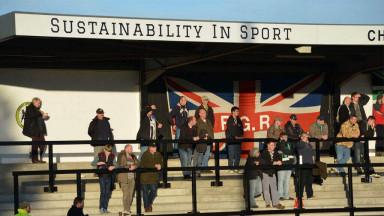Football and Climate Change: An earnest discussion
It might surprise some to know how melting icebergs, rising water levels and temperature rise have direct consequences for football
By Admin | about 4 years ago
Kids playing football on a flooded ground
Global Climate Change (or Crisis as many would prefer calling it) is the biggest talking point in this day and age. You must have already come across phrases like global temperature rise, the Paris Summit and sustainable development. But very few realise the connection that exists between the biggest sport in the world and Climate. We’ll see how melting icebergs, rising water levels and temperature rise have direct consequences for football.
HOW IS IT A PROBLEM?
There are two aspects to it. One, how modern football, with its ever-increasing carbon footprint, contributes to climate change, and two, how it, in turn, impacts the game. The adverse effects of the Climate Crisis on football have already been witnessed in certain parts of the world. You’ll learn of them as you read on.
Let’s look at how football contributes to climate change. The World Land Trust estimated that the 2018/19 Champions League final between Liverpool and Tottenham produced 8,693 tonnes of carbon. To give you an estimate, that is more than what the entire city of Glasgow produces in a day. This came mostly as a result of the flights taken by fans from England to Madrid where the fixture took place. One might wonder, why not host the finals somewhere in England when both clubs involved are English? The same can be said about the latest final between Manchester City and Chelsea that was held in Porto.
Football’s governing bodies are least concerned about sustainability and environmental consequences. The expansionist nature of FIFA and UEFA in the interest of the growth and development of football has sidelined one of the most pressing issues of our generation. FIFA is planning to incorporate 48 teams instead of 32 in the 2026 Men’s World Cup. The Women's World cup is likely to see an increase from 24 teams to 32 and the Club World Cup which consists of 7 teams is about to feature 24 instead, which would increase the number of matches involved significantly. UEFA have also significantly expanded with the creation of the Nations League and adding another tier to their annual European club tournament in the Europa Conference Cup. It may be stating the obvious, but more the number of games, more the carbon emissions.
WILL IT IMPACT FOOTBALL?
Yes, and it has already started. The rising temperatures would affect many tropical countries, making them unfit for playing football as too much heat and humidity poses a huge health hazard for high performing athletes putting them at the risk of dehydration, exhaustion and heatstroke. This is precisely why the 2022 World Cup, to be held in Qatar, will be a winter event rather than a summer event as it otherwise would. Despite being played in winter, games will still be played in stadiums that are air-conditioned to keep the field and stands around 79F. One might argue that Qatar, located on the Persian Gulf is hot anyway due to geographical reasons, but with rising temperatures, more countries would touch those temperatures, making them unfit for playing football.
It is not limited to tropical countries. The problem up north is different. As the world warms, more water evaporates from our seas, oceans and other water bodies. This leads to extreme downpours, increasing the risk and severity of flooding. A survey in England found that, on average, grassroots clubs lose five weeks every season due to bad weather – with more than a third losing between two and three months. Professional clubs are not immune to extreme weather conditions. It was noted that extreme weather events caused the cancellation of 25 Football League fixtures in the 2015/16 season alone. One of the worst-hit was Carlisle United’s, Brunton Park. The League One side was forced out of its home ground for 49 days by Storm Desmond in December 2015, costing them nearly £200,000.
Picture Courtesy of : John Lord
Warwick Road End, Brunton Park, home of Carlisle United
A recent report by Rapid Transition Alliance estimated that within the next three decades, one-quarter of English league football grounds – including Chelsea’s Stamford Bridge, Fulham’s Craven Cottage, West Ham’s London Stadium and Southampton’s St Mary’s – will be at risk of flooding every season. and rising temperatures are likely to make summer tournaments impossible in the not-too-distant future.
HOW DO WE ACT ON CLIMATE CHANGE?
First and foremost, acknowledge the issue at hand. This applies more to people who run football over anyone else. The decision making from the top of the hierarchy has for the most part been inconsiderate and unreasonable when it comes to sustainability. From never-ending fixture lists and odd selections of match venues to creating excessive competitions that are certainly worth reviewing. Football clubs are also known to be complacent in this matter. To give an example, French MEP, Karima Delli, who chairs the European Parliament’s Transport Committee had lashed out at football clubs for their insensitivity towards climate change as big teams opt to fly over short distances instead of choosing more sustainable modes of transport available.
Most of the modern sports kits are 100% plastic and the practice of releasing 3 strips with dozens of other wears to widen the revenue stream is questionable, though there have been changes on this front with clubs opting for recycled plastics and other eco-friendly materials. One club, in particular, Forest Green Rovers, are working on kits made of waste from coffee beans of all things! You’ll get to know more about them later.
The next important step is to pass the message on to the fans. This might seem straightforward, but that isn’t quite the case. According to a survey carried out by researchers at the Institute Management of Sant’Anna School of Advanced Sciences (Pisa, Italy) as part of the Life Tackle project, the majority of football fans are aware of the importance of protecting the environment. But it also demonstrates that although fans are in favour of the football industry being more committed to environmental protection, they do not comprehend their ecological impact and the importance of their commitment.
This misalignment of the ground impact of football matches on climate change and the fan’s perception of the problem is understandable. The aforementioned survey also demonstrates that most of the fans are willing to “avoid wastage of food, water and other resources”, “collect and recycle litter after consumption”, “consciously purchase reusable or biodegradable cups, plates, cutlery etc.” but that is all they can do. They would be doing their bit here but in reality, it won’t make too much of a difference. The reason being that the biggest contributor to the game’s carbon footprint is not the use of single-use plastic or red meats served in stadiums, but the transportation of thousands of fans every year (accounts for over 60% of total environmental impact) besides stadium lighting and water irrigation. Will the fans be inclined to commute by bike or public transport? Most of them wouldn’t, and they can’t be blamed for it. The next section should explain why.
THE CHALLENGES INVOLVED
Football has deep-rooted systemic problems that largely came about as a result of society’s negligence towards the issue and ignorance of those running the sport. When you are fighting a crisis, the strongest response is expected to come from the leadership. The least one would expect is for them to recognise the problem and hold meetings/conferences to discuss the issue and set up a revised framework for football to operate in a manner that would adhere to the standards of The Paris Agreement. All this might seem simple but what you lay out on a paper is very different to how things work on the ground. Generally, it would take a couple of revisions before an effective and acceptable system can be put in place. But so far, the authorities have been in total denial of the problem as their actions suggest.
People participate in Fridays For Future movement to voice their climate change concerns
I had mentioned how the football authorities are focused on the expansion and growth of football whilst completely ignoring its climate consequences. But at least they can make a good case for it, like help support grassroots football or make the game more accessible to people. But how would one justify the sponsorship tie-ups with some of the highest carbon polluters in the world? According to a report published by the New Weather Institute, polluters from oil and gas companies to airlines and automobile industries are pouring millions as an attempt to "sports-wash", across multiple sports. The report identifies a total of 258 sports sponsorship deals in various countries.
These companies promote high carbon products, services and lifestyles and to escape criticism for the damage that they inadvertently cause to the public, they penetrate sports and use it as a medium to improve their relationship and reputation among people. They establish a relationship with the supporters of the club they sponsor. As a result, they’re not only able to strengthen their consumer base but also normalize polluting lifestyles, leaving the people completely ignorant of its consequences. Yes, big corporations have the power to influence large communities and set new social norms. This is why sports sponsorship matters! Having Emirates, Etihad, Gazprom, Continental, Toyota among many others as your sponsor doesn’t send a good message while the world is battling a climate crisis.
I had previously outlined the various factors that contribute to climate change in football, the most significant one being transportation. Whether it’s a European away leg or a big international event, thousands of fans flying to games is highly damaging in the long run. The same stands true for millions of fans driving to games during a season. Is it reasonable to ask the fans to give up their cars and use public transport instead? Certainly not. The situation demands serious actions but at the same time, it might be unfair to the fans if they are asked to make too many compromises especially during these tough times of pandemic while the owners and authorities are oblivious to the crisis. So striking a balance is important.
There are many areas where public transport facilities are poor. Some of the common complaints fans have are, buses not arriving on time or their frequency being too low, transport is not well connected to the stadium and having to walk a considerable distance before reaching the spot, in which case private vehicle becomes inevitable. Problems of such nature are to be resolved by the authority and not the fans alone. They can at best voice their concerns but it’s the people in power who should take cognizance of the situation and address it. They can even go a step further and incentivise and/or subsidise the use of public transport, bikes and electric vehicles to promote and encourage people to use low carbon consuming modes of transport.
A RAY OF HOPE
As people realise the depth of the problem and begin to voice their concerns, clubs and other football bodies are bound to listen and act. There appears to be a sense of acceptance in the football industry of late and steps are being taken to mitigate the damage caused to the environment.
Arsenal Football Club is the first Premier League club to sign up to the UN Sports for Climate Action Framework. As per a study published by BBC in 2019 Arsenal have been ranked as the most sustainable Premier League club. The club was the first in the country to install large-scale battery energy storage in 2018 that can power the stadium for an entire match. They have also made significant steps in water recycling, plantation of trees, reduction in consumption of single-use plastic, installation of LED lights and production of green electricity. Tottenham, Liverpool and Southampton also followed suit in signing the Climate Action Framework.
Picture Courtesy of : Hzh
Tottenham Hotspur Stadium June 2019, view from east
Spurs have been named the Premier League’s greenest club. They’ve achieved this milestone by taking significant measures to cut their carbon footprint which include opting for clean and renewable energy sources to power their stadiums, offices and training centres, reducing the usage of single-use plastic, efficient energy and water consumption, promoting vegan food and most importantly engaging with the people to raise awareness on the issue. The most impressive of all is their zero-to-landfill waste management policy which aims to reuse/recycle the bulk of the waste produced by the club. They do it by designating separate bins for dry and wet waste, the dry waste collected is later transferred to a nearby Material Recovery Facility, where the waste is segregated to produce single-stream materials that are later sent for reprocessing.
The initiative is not only limited to Premier League clubs. In Germany, both clubs and fans have taken huge efforts to combat climate change. Bundesliga clubs have taken substantial steps to mitigate CO2 emissions and opt for other greener alternatives. The first football team from a major European League to adopt the Climate Action Framework was VfL Wolfsburg. The club is also best known to publish sustainability reports that provide a comprehensive overview of its carbon footprint, as well as power consumption, water consumption, paper consumption and waste volume. FC Mainz, who have been climate neutral since 2010, offered 500 travelling fans a subsidized special train service for an away game against Schalke on Sept 20, 2019, in support of the “Fridays for Future” campaign. Though the match ended in a defeat, they won many hearts as their action was lauded by people across the world. Many clubs in Germany are already carbon neutral and have equipped their stadiums with solar panels, wells and heat pumps, LED lighting and other climate-friendly alternatives.
Not only clubs, but even sports personalities have come out in public and expressed their support for sustainability and promoting a greener lifestyle. Arsenal defender Hector Bellerin has talked about his vegan diet in public and how it has helped him on and off the pitch. Last year, Bellerin pledged to plant 3000 trees in the Amazon for every victory his team registers in the season to highlight the need to tackle climate change. Furthermore, the Spanish defender becomes the second-highest shareholder in Forest Green Rovers, the world’s most environmentally sustainable football club (more on them later) in a bid to support their climate-friendly venture. Former Arsenal, AC Milan and Crystal Palace midfielder Mathieu Flamini co-founded a company named GF Biochemicals, the first company to mass-produce a naturally occurring chemical called Levulinic acid, a potential substitute for oil. Peter Crouch, the towering English footballer, has supported the efforts to tackle climate change. He was among the 124 signatories of a letter that urged wealthy countries to declare a climate emergency and cut down on carbon emissions to prevent global warming before it’s too late. The famous television presenter and former English footballer, Gary Lineker has also publicly voiced his concerns over climate change on many occasions.
Nike had announced that their football kits are made of recycled plastic bottles. The process involves chopping the bottles into flakes, melting them and then spinning the material into the yarn. More Premier League Clubs are now joining in to combat the Climate Crisis.
THE CURIOUS CASE OF FOREST GREEN ROVERS
If you’re wondering to what extent a football club could go climate-friendly, look no further than this League Two club based in Gloucestershire, a county in South West England. The first football club to go carbon neutral, Forest Green Rovers is recognized by FIFA as the ‘world’s greenest football club’ and rightly so, for the efforts they’ve taken to cut their carbon dependence is monumental.
Picture Courtesy of : nicksarebi
The New Lawn Stadium, home of Forest Green Rovers
Consider their home ground, The New Lawn Stadium for example. The pitch is fully organic free from pesticides and irrigated with rainwater that is collected and recycled around the stadium. They own a ‘mow bot’, which is a solar-powered robotic lawnmower, first to be ever used in British football.
The entire club is powered by 100% green energy generated from the firm Ecotricity, most of which is generated onsite from the solar panels installed on the stadium’s roof. The club’s kits are made of 50% bamboo instead of plastic and they’re now trialling a kit made from recycled coffee bean waste! Moreover, the Rovers are 100% vegan, as they encourage and sell only vegan foods on matchday. The club might belong in the fourth tier of English football, but when it comes to sustainability, they are surely in a league of their own.
CAN FOOTBALL MAKE A DIFFERENCE?
The football industry must not only act because its future is in peril. Being the largest and most followed sport on the planet comes with its share of responsibilities. Football has made it possible for billions of people to set aside their differences and join hands in support of their team. If the entire football community could unite and pledge its support in the fight against the climate crisis, the message would be so loud and strong that it won’t be long until the rest of the world follows suit. Not only would it help spread awareness but also mobilise a large number of people into taking action for a global cause. Football has always played an active role to help tackle various social issues like racism, LGBTQ+ rights etc. The issue of Climate Change is equally pressing and the whole world will earnestly look at how football responds to it.














